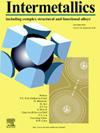Microstructure and dynamic mechanical properties of an additive manufacturing titanium alloy by direct energy deposition
IF 4.3
2区 材料科学
Q2 CHEMISTRY, PHYSICAL
引用次数: 0
Abstract
Additive manufacturing (AM), characterized by its rapid melting-cooling process, offers novel metallurgical pathways for developing advanced alloys. This study fabricated a novel multi-element titanium alloy using Ti-6Al-4V (Ti64) and NiCrFeCoMo0.2 high-entropy alloy (HEA) powders via direct energy deposition (DED). Microstructural analysis revealed elemental segregation of HEA components at melt pool boundaries in Ti64+2HEA and Ti64+6HEA, whereas Ti64 + 16HEA exhibited uniform HEA distribution across melt pool boundaries. The Ti64 + 16HEA alloy comprised a single-phase β matrix with precipitates predominantly distributed along grain boundaries. Dynamic mechanical testing via split-Hopkinson pressure bar (SHPB) demonstrated exceptional performance in Ti64 + 16HEA, achieving a dynamic yield strength of 2116.6 MPa and a compressive ratio of 7.4 % at a strain rate of approximately 1260 s−1. During DED processing, Ti64 + 16HEA possessed a sufficient molybdenum equivalent (MoE) to stabilize the single-phase β structure. The incorporation of HEA into Ti64 introduced a complex alloying composition, mitigating the formation of singular brittle precipitates and thereby optimizing the alloy's strength-ductility synergy. Under dynamic deformation, the β matrix and its precipitates in Ti64 + 16HEA uniformly redistributed stress waves, enhancing strength while alleviating tensile stress concentration. This mechanism prevented premature failure, enabling an optimal balance between strength and ductility in Ti64 + 16HEA.

直接能量沉积增材制造钛合金的显微组织和动态力学性能
增材制造(AM)以其快速的熔融冷却过程为特点,为开发先进合金提供了新的冶金途径。以Ti-6Al-4V (Ti64)和NiCrFeCoMo0.2高熵合金(HEA)粉末为原料,采用直接能量沉积(DED)法制备了新型多元素钛合金。微观结构分析表明,Ti64+2HEA和Ti64+6HEA在熔池边界处存在HEA元素偏析,而Ti64+ 16HEA在熔池边界处HEA元素分布均匀。Ti64 + 16HEA合金由单相β基体组成,析出相主要沿晶界分布。通过分离式霍普金森压杆(SHPB)进行的动态力学测试表明,Ti64 + 16HEA具有优异的性能,在应变速率约为1260 s−1时,动态屈服强度达到2116.6 MPa,压缩比达到7.4%。在DED过程中,Ti64 + 16HEA具有足够的钼当量(MoE)来稳定单相β结构。将HEA掺入Ti64后,形成了复杂的合金成分,减少了单一脆性析出物的形成,从而优化了合金的强度-塑性协同作用。在动态变形下,Ti64 + 16HEA中的β基体及其析出相均匀地重新分布应力波,增强了强度,缓解了拉应力集中。这种机制防止了过早破坏,使Ti64 + 16HEA的强度和延展性达到最佳平衡。
本文章由计算机程序翻译,如有差异,请以英文原文为准。
求助全文
约1分钟内获得全文
求助全文
来源期刊

Intermetallics
工程技术-材料科学:综合
CiteScore
7.80
自引率
9.10%
发文量
291
审稿时长
37 days
期刊介绍:
This journal is a platform for publishing innovative research and overviews for advancing our understanding of the structure, property, and functionality of complex metallic alloys, including intermetallics, metallic glasses, and high entropy alloys.
The journal reports the science and engineering of metallic materials in the following aspects:
Theories and experiments which address the relationship between property and structure in all length scales.
Physical modeling and numerical simulations which provide a comprehensive understanding of experimental observations.
Stimulated methodologies to characterize the structure and chemistry of materials that correlate the properties.
Technological applications resulting from the understanding of property-structure relationship in materials.
Novel and cutting-edge results warranting rapid communication.
The journal also publishes special issues on selected topics and overviews by invitation only.
 求助内容:
求助内容: 应助结果提醒方式:
应助结果提醒方式:


